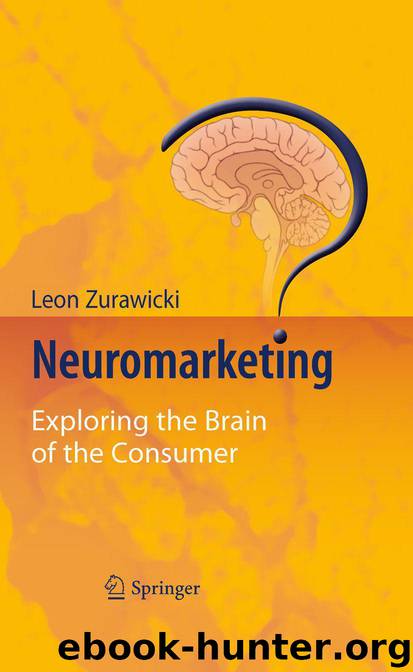Neuromarketing: Exploring the Brain of the Consumer by Zurawicki Leon

Author:Zurawicki, Leon [Zurawicki, Leon]
Language: eng
Format: mobi
Publisher: Springer Berlin Heidelberg
Published: 2010-09-01T14:00:00+00:00
3.8 Feeling the Pinch: Paying the Price
In most considerations regarding acquisition of products/services their cost plays a prominent role. The expected cost (not always the price alone) to the consumer may serve as an indicator of value and certainly a tool in comparing options available. Because price is formulated as a single number – and seldom re-framed by consumers in terms of how much time and effort one needs to expend to earn the equivalent amount of money – it offers convenience for the sake of choice deliberations.
The first question which comes to mind when considering the price is whether paying is synonymous with pain. The second relevant issue is whether the sacrifice in terms of quid pro quo, i.e. money for goods, can be neurologically linked to what is known about the risk management mechanisms in the brain. After all, the (opportunity) cost of the acquired item reflects the possibility of getting the desired value or not. All of the above affect the consumers’ sensitivity to price. Knutson et al. (2007) shed light on neural modeling of value. In scanning the brain of the subjects simulating buying, the brain responses to product preferences and corresponding prices were monitored. Out of the possible options, the activity of the NAcc proved much stronger at the moment when the participants got exposed to the preferred, i.e. subsequently “purchased” product. In conjunction with the survey data on participants’ liking of presented products and their idea of the “right” price relative to the one they were quoted it was then possible to map the brain correlates of the experimentally brief purchase cycle. Product liking corresponded closely and expectedly with the activation of the NAcc during the full course of the presentation, i.e. the product, product and price, and the choice stage. As far as disclosure of price information was concerned, the unattractive price stimulated the right insula signaling irritation and simultaneously de-activated the mesial prefrontal cortex (MPFC) prior to the purchase decision. Since this area is known for, among others, its role in weighting the potential gains and losses against each other, the lack of activity signals the “no deal” attitude. Taken together, the study in question helped to depict the neural architecture of the pleasure of the expectation of possession vs. the pain of paying for it and suggests clearly that there is more than a single “buy button” in the brain. Remarkably, the activity indices in the NAcc and the right insula independently predicted immediately subsequent purchases of the items offered and highlighted the emotional range of the inputs leading to the decision. Further, the insula connection shows that in a similar way as taking the risk is not a cold-blooded commitment, the price-reviewing part of the decision process is not devoid of emotions.
Money is a precious resource and the sheer task of counting it, preferably in large bills, produces positive psychological effects such as the attenuation of physical and social pain (Zhou et al. 2009). It is best possible that handling money evokes the feeling of owning a treasure and the associated pleasure of power.
Download
This site does not store any files on its server. We only index and link to content provided by other sites. Please contact the content providers to delete copyright contents if any and email us, we'll remove relevant links or contents immediately.
| Direct | Global |
| Industrial | Multilevel |
| Product Management | Research |
| Telemarketing | Web Marketing |
Influence: The Psychology of Persuasion by Robert B. Cialdini(4716)
The Miracle Morning by Hal Elrod(4638)
The Hacking of the American Mind by Robert H. Lustig(4319)
Pre-Suasion: A Revolutionary Way to Influence and Persuade by Robert Cialdini(4151)
Unlabel: Selling You Without Selling Out by Marc Ecko(3591)
Ogilvy on Advertising by David Ogilvy(3512)
Hidden Persuasion: 33 psychological influence techniques in advertising by Marc Andrews & Matthijs van Leeuwen & Rick van Baaren(3474)
Purple Cow by Seth Godin(3142)
Who Can You Trust? by Rachel Botsman(3089)
Kick Ass in College: Highest Rated "How to Study in College" Book | 77 Ninja Study Skills Tips and Career Strategies | Motivational for College Students: A Guerrilla Guide to College Success by Fox Gunnar(3077)
The Marketing Plan Handbook: Develop Big-Picture Marketing Plans for Pennies on the Dollar by Robert W. Bly(2977)
This Is Marketing by Seth Godin(2974)
I Live in the Future & Here's How It Works by Nick Bilton(2938)
The Power of Broke by Daymond John(2899)
Building a StoryBrand by Donald Miller(2843)
The Tipping Point by Malcolm Gladwell(2828)
The 46 Rules of Genius: An Innovator's Guide to Creativity (Voices That Matter) by Marty Neumeier(2797)
Draw to Win: A Crash Course on How to Lead, Sell, and Innovate With Your Visual Mind by Dan Roam(2739)
Market Wizards by Jack D. Schwager(2644)
